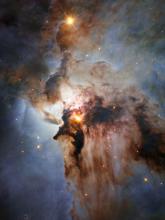Listen to today's episode of StarDate on the web the same day it airs in high-quality streaming audio without any extra ads or announcements. Choose a $8 one-month pass, or listen every day for a year for just $30.
You are here
Sagittarius Nurseries
Our home galaxy, the Milky Way, is home to hundreds of billions of stars — and the population is growing all the time. New stars are taking shape inside vast clouds of gas and dust. And several of these clouds are visible in the constellation Sagittarius, which scoots low across the south on summer nights.
The brightest of these clouds is M8, the Lagoon Nebula. If you have especially dark skies, it’s visible to the unaided eye as a faint smudge of light. But telescopes reveal rich details, including a dark streak across the nebula — like a lagoon cutting into a tropical island.
The bright part of the nebula is too hot to give birth to new stars. But dark veins and bubbles of colder gas are mixed in, and these are busy stellar nurseries. They’ve given birth to several dozen stars in the Lagoon. At around four million years old, they’re some of the youngest stars in the entire galaxy.
Another nursery is just to the northwest of the Lagoon: M20, the Trifid Nebula. Through a telescope, it looks like it’s split into thirds by veins of cold gas and dust. Hot young stars near the center of the nebula pump out ultraviolet energy. That causes the surrounding gas to glow like a fluorescent bulb — the light of a stellar nursery.
Sagittarius is low in the south as night falls. Its brightest stars form the shape of a teapot. M8 and M20 stand a little above the spout of the teapot.
We’ll have more about Sagittarius tomorrow.
Script by Damond Benningfield



